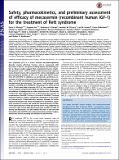| dc.contributor.author | Khwaja, Omar S. | |
| dc.contributor.author | Ho, Eugenia | |
| dc.contributor.author | Barnes, Katherine V. | |
| dc.contributor.author | O'Leary, Heather M. | |
| dc.contributor.author | Pereira, Luis M. | |
| dc.contributor.author | Finkelstein, Yaron | |
| dc.contributor.author | Nelson III, Charles A. | |
| dc.contributor.author | Vogel-Farley, Vanessa | |
| dc.contributor.author | DeGregorio, Geneva | |
| dc.contributor.author | Holm, Ingrid A. | |
| dc.contributor.author | Khatwa, Umakanth | |
| dc.contributor.author | Kapur, Kush | |
| dc.contributor.author | Alexander, Mark E. | |
| dc.contributor.author | Finnegan, Deidre M. | |
| dc.contributor.author | Cantwell, Nicole G. | |
| dc.contributor.author | Walco, Alexandra C. | |
| dc.contributor.author | Rappaport, Leonard | |
| dc.contributor.author | Gregas, Matt | |
| dc.contributor.author | Fichorova, Raina N. | |
| dc.contributor.author | Shannon, Michael W. | |
| dc.contributor.author | Sur, Mriganka | |
| dc.contributor.author | Kaufmann, Walter E. | |
| dc.date.accessioned | 2014-11-06T18:21:18Z | |
| dc.date.available | 2014-11-06T18:21:18Z | |
| dc.date.issued | 2014-03 | |
| dc.date.submitted | 2013-06 | |
| dc.identifier.issn | 0027-8424 | |
| dc.identifier.issn | 1091-6490 | |
| dc.identifier.uri | http://hdl.handle.net/1721.1/91474 | |
| dc.description.abstract | Rett syndrome (RTT) is a severe X-linked neurodevelopmental disorder mainly affecting females and is associated with mutations in MECP2, the gene encoding methyl CpG-binding protein 2. Mouse models suggest that recombinant human insulin-like growth factor 1 (IGF-1) (rhIGF1) (mecasermin) may improve many clinical features. We evaluated the safety, tolerability, and pharmacokinetic profiles of IGF-1 in 12 girls with MECP2 mutations (9 with RTT). In addition, we performed a preliminary assessment of efficacy using automated cardiorespiratory measures, EEG, a set of RTT-oriented clinical assessments, and two standardized behavioral questionnaires. This phase 1 trial included a 4-wk multiple ascending dose (MAD) (40–120 μg/kg twice daily) period and a 20-wk open-label extension (OLE) at the maximum dose. Twelve subjects completed the MAD and 10 the entire study, without evidence of hypoglycemia or serious adverse events. Mecasermin reached the CNS compartment as evidenced by the increase in cerebrospinal fluid IGF-1 levels at the end of the MAD. The drug followed nonlinear kinetics, with greater distribution in the peripheral compartment. Cardiorespiratory measures showed that apnea improved during the OLE. Some neurobehavioral parameters, specifically measures of anxiety and mood also improved during the OLE. These improvements in mood and anxiety scores were supported by reversal of right frontal alpha band asymmetry on EEG, an index of anxiety and depression. Our data indicate that IGF-1 is safe and well tolerated in girls with RTT and, as demonstrated in preclinical studies, ameliorates certain breathing and behavioral abnormalities. | en_US |
| dc.description.sponsorship | Rett Syndrome Foundation (Grant 2534) | en_US |
| dc.description.sponsorship | Autism Speaks (Organization) (Grant 5795) | en_US |
| dc.description.sponsorship | National Institutes of Health (U.S.) (Harvard Clinical and Translational Science Center, Grant 1 UL1 RR 025758-01) | en_US |
| dc.description.sponsorship | Boston Children’s Hospital (Translational Research Program) | en_US |
| dc.description.sponsorship | Boston Children’s Hospital (Intellectual and Developmental Disabilities Research Center P30 HD18655) | en_US |
| dc.language.iso | en_US | |
| dc.publisher | National Academy of Sciences (U.S.) | en_US |
| dc.relation.isversionof | http://dx.doi.org/10.1073/pnas.1311141111 | en_US |
| dc.rights | Article is made available in accordance with the publisher's policy and may be subject to US copyright law. Please refer to the publisher's site for terms of use. | en_US |
| dc.source | PNAS | en_US |
| dc.title | Safety, pharmacokinetics, and preliminary assessment of efficacy of mecasermin (recombinant human IGF-1) for the treatment of Rett syndrome | en_US |
| dc.type | Article | en_US |
| dc.identifier.citation | Khwaja, O. S., E. Ho, K. V. Barnes, H. M. O’Leary, L. M. Pereira, Y. Finkelstein, C. A. Nelson, et al. “Safety, Pharmacokinetics, and Preliminary Assessment of Efficacy of Mecasermin (recombinant Human IGF-1) for the Treatment of Rett Syndrome.” Proceedings of the National Academy of Sciences 111, no. 12 (March 12, 2014): 4596–4601. | en_US |
| dc.contributor.department | Massachusetts Institute of Technology. Department of Brain and Cognitive Sciences | en_US |
| dc.contributor.mitauthor | Sur, Mriganka | en_US |
| dc.relation.journal | Proceedings of the National Academy of Sciences | en_US |
| dc.eprint.version | Final published version | en_US |
| dc.type.uri | http://purl.org/eprint/type/JournalArticle | en_US |
| eprint.status | http://purl.org/eprint/status/PeerReviewed | en_US |
| dspace.orderedauthors | Khwaja, O. S.; Ho, E.; Barnes, K. V.; O'Leary, H. M.; Pereira, L. M.; Finkelstein, Y.; Nelson, C. A.; Vogel-Farley, V.; DeGregorio, G.; Holm, I. A.; Khatwa, U.; Kapur, K.; Alexander, M. E.; Finnegan, D. M.; Cantwell, N. G.; Walco, A. C.; Rappaport, L.; Gregas, M.; Fichorova, R. N.; Shannon, M. W.; Sur, M.; Kaufmann, W. E. | en_US |
| dc.identifier.orcid | https://orcid.org/0000-0003-2442-5671 | |
| mit.license | PUBLISHER_POLICY | en_US |
| mit.metadata.status | Complete | |
